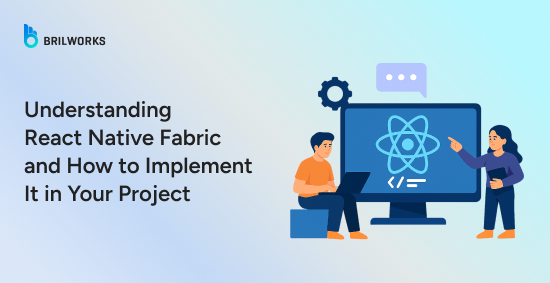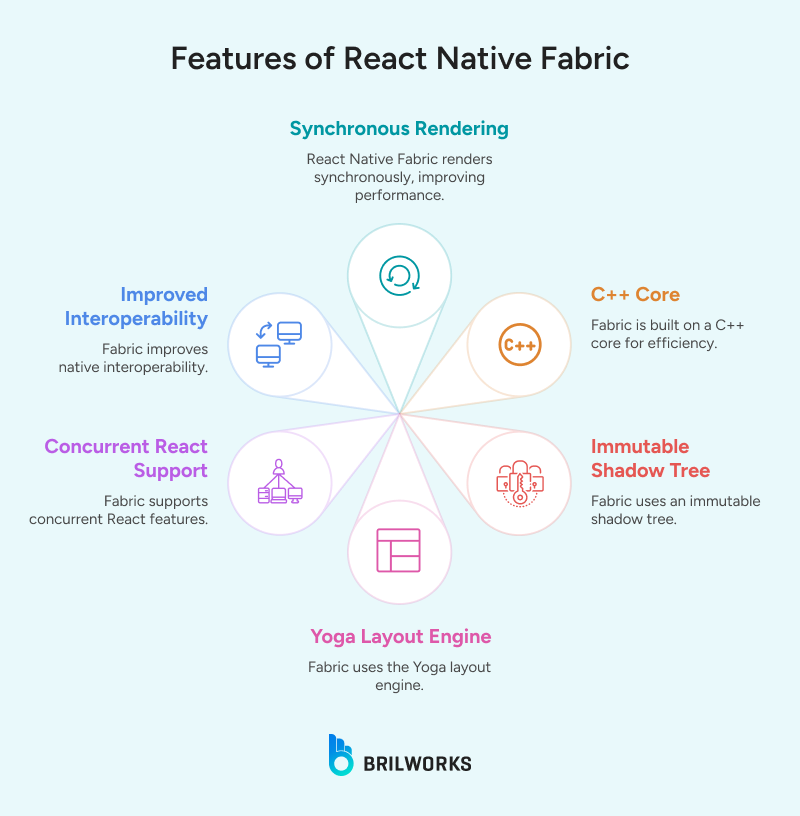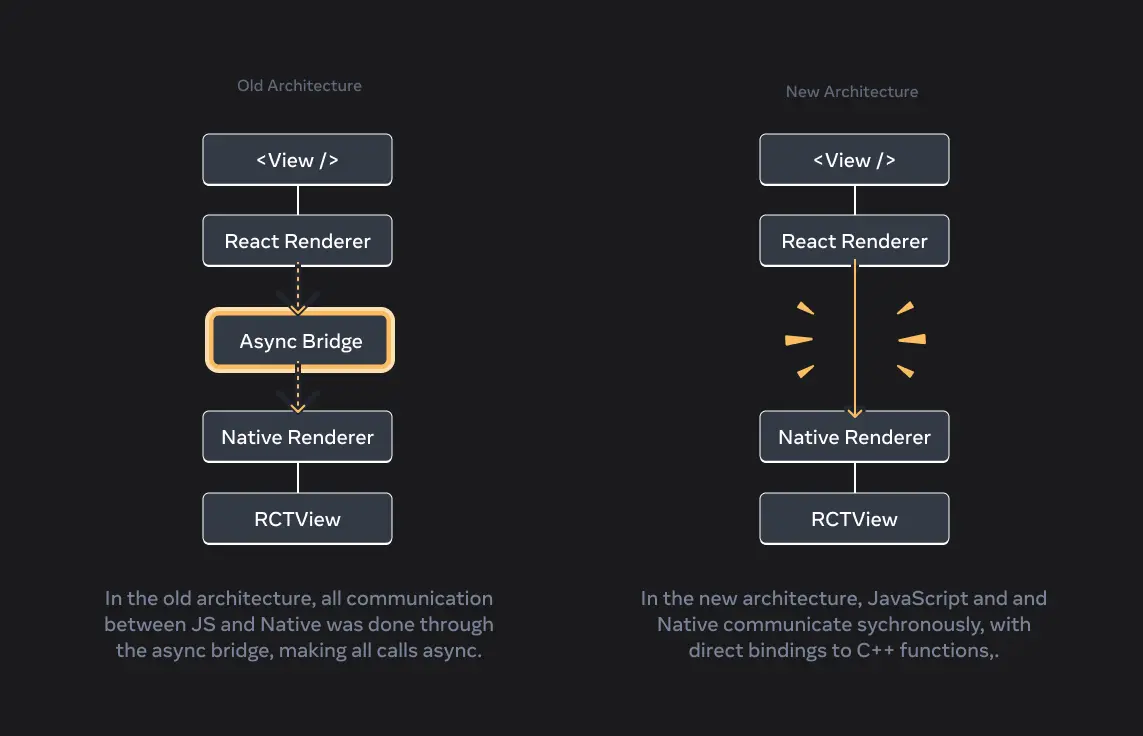COOPERATION MODEL
ARTIFICIAL INTELLIGENCE
PRODUCT ENGINEERING
DevOps & Cloud
LOW-CODE/NO-CODE DEVELOPMENT
INDUSTRY
FRONTEND DEVELOPMENT
CLOUD DEVELOPMENT
MOBILE APP DEVELOPMENT
LOW CODE/ NO CODE DEVELOPMENT
EMERGING TECHNOLOGIES








Choosing the right architecture is critical for building high-performance mobile apps. React Native has grown into one of the most popular frameworks for cross-platform development, backed by a vibrant community and over 120k stars on GitHub.
Since its launch, React Native has evolved through two major architectures. The original, known as Legacy Architecture or Paper, provided a solid foundation, but it had limitations, especially in handling complex UI updates efficiently. In 2018, work began on a new system called Fabric, designed to overcome these challenges.
Today, Fabric represents a foundational shift in how React Native interacts with native components and manages UI updates, bringing the framework closer to modern React principles.
In this guide, we will explore React Native Fabric architecture 2025, explain its features, benefits, use cases, and provide a step-by-step approach to implementing it in your project.
Get expert guidance and hands-on support from a react native app development company trusted by startups and enterprises for smooth, reliable releases.
Fabric is the modern rendering system that powers the new React Native architecture. Unlike the legacy bridge-based system, Fabric allows a more direct connection between JavaScript and native layers. It leverages React Fiber, React’s own rendering engine, to manage UI updates efficiently.
One of the main advantages of Fabric is concurrent rendering. This means the UI can be updated without blocking the main thread, allowing changes to pause, resume, or even abort as needed. This results in smoother interactions, faster animations, and a more responsive experience overall.
Fabric started as a preview in React Native 0.70 and became the default in version 0.76. It enables apps to take full advantage of native features, improved performance, and easier integration with native modules.
If you are planning a new project, collaborating with a React Native development company can help you leverage Fabric to build high-performance, modern mobile apps.
Fabric introduces several features that improve performance, consistency, and the overall developer experience:

Fabric uses the JavaScript Interface (JSI) to allow direct, synchronous communication between JavaScript and native code. This bypasses the need for serialization, so UI changes in JavaScript are immediately reflected in the native layer. This leads to smoother animations, faster scrolling, and near-native performance.
The rendering logic is implemented in C++, providing a cross-platform engine that handles rendering efficiently across iOS, Android, and other platforms. A shared core reduces platform-specific code, ensures consistent behavior, and simplifies maintenance.
Fabric represents UI using an immutable shadow tree, a read-only hierarchy of components. Whenever the UI changes, a new tree is created, reusing unchanged nodes. This approach prevents conflicts from simultaneous updates and ensures consistent rendering.
Fabric continues to use the Yoga layout engine, a Flexbox-based system. Fabric integrates Yoga more closely with the rendering pipeline, improving layout speed and accuracy across screen sizes and platforms.
Fabric fully supports Concurrent React, allowing multiple UI updates to run simultaneously. It prioritizes critical updates while less important tasks are handled in the background, preventing freezes or slowdowns.
Fabric simplifies communication between JavaScript and native modules. Developers can integrate native features more seamlessly, making React Native apps feel truly native without compromising performance.
In the legacy system, React Native had three separate threads—the JavaScript thread, the shadow tree layout thread, and the UI thread—communicating through an asynchronous bridge. This often caused delays, especially in complex apps.
Fabric replaces this with direct, synchronous communication between JavaScript and native components. Rendering logic is unified through a shared C++ core, and modern concepts such as immutable shadow trees and concurrent rendering are fully supported.

|
Aspect |
Legacy Architecture (Paper) |
New Architecture (Fabric) |
|
UI Updates |
Asynchronous via bridge |
Synchronous and direct |
|
Communication |
JavaScript ↔ Native over bridge |
Tighter, more efficient integration |
|
Shadow Tree |
Mutable and handled separately |
Immutable and efficiently managed |
|
Rendering Logic |
Platform-specific |
Unified C++ core across platforms |
|
React Version Compatibility |
Limited support for Concurrent React |
Full support for Concurrent React |
|
Native Module Interaction |
Slower, bridge-dependent |
Faster, flexible native interoperability |

Fabric enforces strong type safety between JavaScript and native code. Property mismatches are caught during build time, reducing runtime errors. This is especially valuable for large apps with multiple teams working on the same components.
A single rendering engine across platforms ensures consistency, simplifies updates, and allows React Native to expand to new platforms without rewriting the rendering logic.
Fabric allows synchronous layout calculations, making it easy to embed React Native views into native apps or use native components without glitches or delays.
Concurrent rendering and lazy component loading reduce startup time and memory usage, leading to smoother, more responsive apps.
JSI replaces the legacy JSON-based bridge, allowing direct communication between JavaScript and native code. This reduces latency and makes heavy UI updates, such as animations or scrolling, faster and more efficient.

Large-Scale Applications: Strong type safety and shared rendering logic simplify scaling apps with complex UIs.
Apps with Embedded Native Views: Improved interoperability ensures React Native views integrate smoothly with native screens.
Performance-Critical Products: Concurrent rendering and reduced communication overhead enable smooth animations and fast interactions.
Cross-Platform Apps: A shared C++ core ensures consistent behavior across iOS, Android, and future platforms.
Developer Tooling and Automation: Fabric-ready components and automatic code generation fit seamlessly into modern CI/CD pipelines.
Ensure your project uses React Native 0.71 or higher. Run:
npx react-native --versionFabric is part of the new architecture alongside TurboModules and JSI.
iOS (Podfile):
:new_architecture_enabled => trueThen:
cd ios && pod installAndroid (gradle.properties):
newArchEnabled=trueRebuild the app:
npx react-native run-ios# or
npx react-native run-androidCheck the logs for “Running app with Fabric enabled.”
Not all components are Fabric-enabled by default. Use Fabric-compatible libraries or custom components to take full advantage of its features. The community and core team are gradually migrating components to support Fabric.
React Native Fabric architecture addresses performance and scalability challenges in modern mobile development. It enables smoother UI, improved native integration, and a more reliable foundation for cross-platform apps.
Adopting Fabric ensures faster rendering, better consistency across platforms, and a scalable architecture for future growth. Collaborating with a React Native development company can help your team make the most of these advancements while delivering high-performance mobile apps.
Fabric is the modern rendering system in React Native’s new architecture. It improves UI performance, supports concurrent rendering, and enables tighter integration between JavaScript and native layers. This makes apps smoother, faster, and more responsive.
Fabric is the modern rendering system in React Native’s new architecture. It improves UI performance, supports concurrent rendering, and enables tighter integration between JavaScript and native layers. This makes apps smoother, faster, and more responsive.
Legacy React Native used a bridge to communicate asynchronously between JavaScript and native code, which could cause delays in complex apps. Fabric replaces this with synchronous communication, a shared C++ core, and an immutable shadow tree, resulting in faster UI updates and better performance.
Not all components are Fabric-ready by default. Core React Native components and many community libraries are gradually migrating to Fabric. You can also create custom Fabric-enabled components to take full advantage of its features.
Fabric is part of the new architecture and can be enabled starting with React Native 0.71. On iOS, set :new_architecture_enabled => true in your Podfile and run pod install. On Android, add newArchEnabled=true to gradle.properties, then rebuild the app.
By 2025, Fabric has become the default for high-performance apps. It improves rendering speed, reduces communication overhead, supports concurrent React, and ensures smoother integration with native modules. This makes it ideal for cross-platform, performance-critical, and large-scale applications.
Get In Touch
Contact us for your software development requirements
Get In Touch
Contact us for your software development requirements